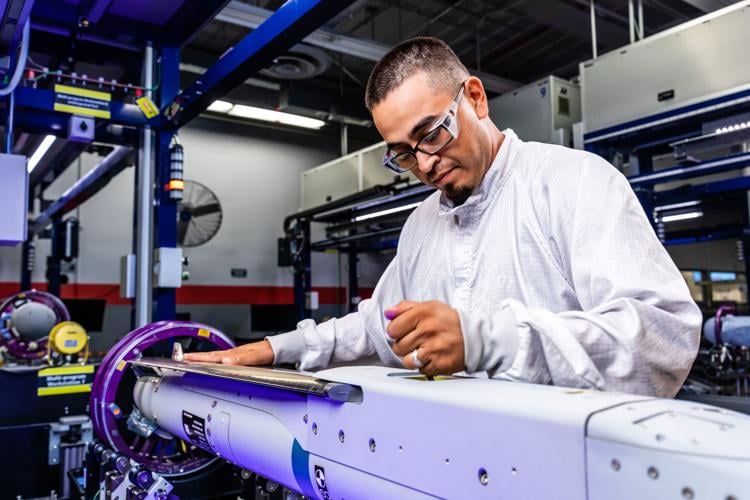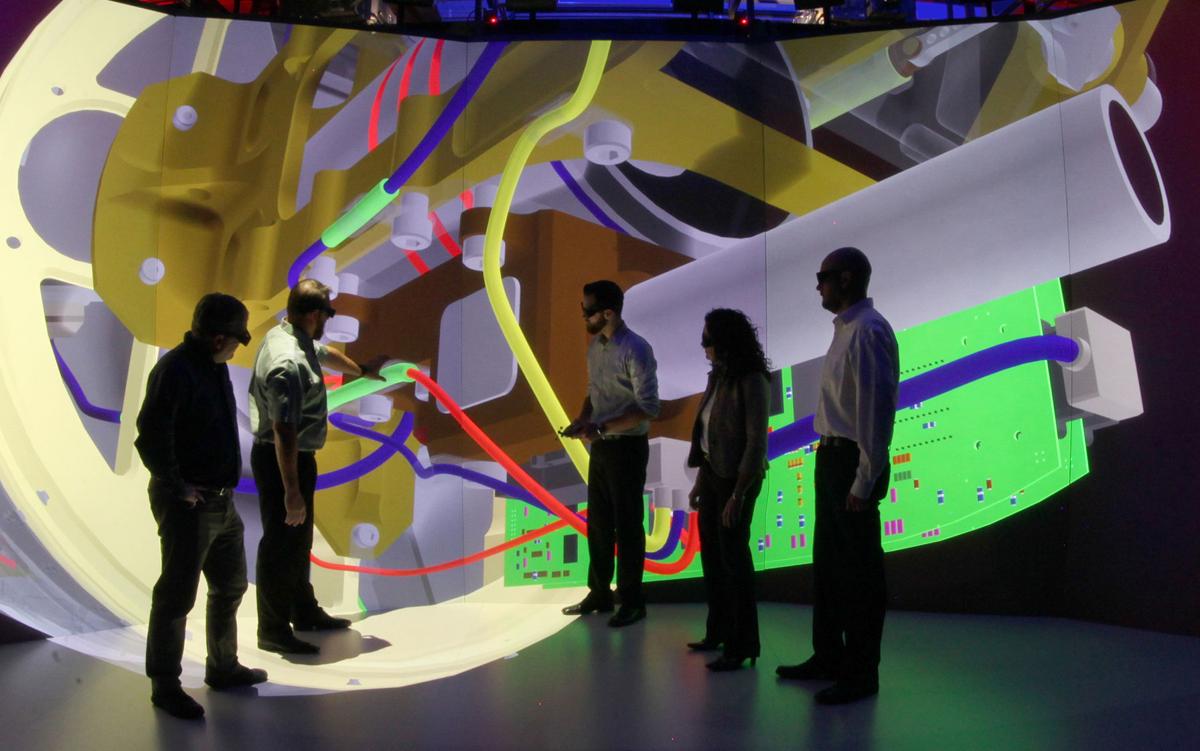Scrambling to meet demand for its weapon systems amid the Ukraine war and emerging threats to U.S. security, Raytheon is amping up its post-pandemic hiring efforts at its missile plants in Tucson.
Raytheon, maker of many the nation’s front-line weapons and the Tucson region’s biggest employer with about 12,000 local workers, is offering flexible and hybrid work schedules, using artificial intelligence to screen job candidates, and even offering lucrative sign-on bonuses to fill certain critical positions, amid fierce competition for engineers and other workers.
But Raytheon’s human-resources chief says the defense industry — and its customers at the Pentagon — must do more to adapt to a skin-tight labor market and needs of job prospects.
Jennifer Brummund, Raytheon’s chief human resources officer, says contractors like Raytheon are doing their part by driving internships and apprenticeships, offering job flexibility and using technologies like artificial intelligence to screen candidates.
But the Pentagon can help by streamlining employee security-clearance and program procedures, Brummund says.
In an interview with the Star, Brummund said that Pentagon rules requiring high-level qualifications such as doctorate degrees and security-clearance eligibility makes it challenging to hire engineers in a highly competitive labor market.
“It’s our customers allowing us to expand the talent pool that we can tap into,” said Brummund, who joined Raytheon in 2014 and served in various senior human resources roles including vice president before being named chief HR officer in July.

Brummund
Though Raytheon itself imposes some degree requirements, the Defense Department has its own set of requirements for some programs, she noted.
Degrees and clearance
Brummund recalled a software engineering leader at Raytheon several years ago who was frustrated he couldn’t hire otherwise qualified job candidates because they lacked a degree required under program rules.
“Some of the best hackers are not in college, they don’t have degrees, right?” she said. “Those are the people we need working for us, so that’s that piece of helping us think broader, if we’re going to have the support and the talent we need in the defense industry, for Raytheon certainly but even beyond that, if we just look at the whole industry, we need to be a little more thoughtful about it.”
The Pentagon and Congress should look at streamlining the employee security-clearance process, as well as reviewing changes to the classification of program documents, Brummund said.
She noted that Rep. Jason Crow, D-Colo., raised the issue in March at a conference of the Center for Strategic and International Studies, where he also advocated for pre-clearances for interns and apprentices at the high school and college level.
There are several individual U.S. security clearance levels — confidential, secret, top secret and an add-on to top secret known as “sensitive compartmented information.”
A related but separate status known as “special access program” or SAP, is attached to some information, which can take a long time to obtain and create staffing challenges, Brummund said.
“You may have a top-secret clearance, and then to work on a particular program you may need additional levels, or what we would call ‘tickets,’ to then do work within a particular program or project,” she said.
Brummund said the company has encouraged its various Defense Department customers to identify information early in a program’s development phase that doesn’t really need to be classified.
“There’s work that we do that needs to be classified at absolutely the highest level,” she said. “But could the workstream be pulled apart in such a way that we’re able to open up work to unclassified, or a lower level of classification so that we can move quicker?”
She noted that getting various clearances on a particular program can take so long, it’s hard for the company to move a cleared employee to another program.
Raytheon also is allowing some employees to work flexible hours, or work remotely or take “remote days” where possible, but some classified work requires employees to work in secure facilities, Brummund noted.

Raytheon engineers in Tucson use virtual reality systems to help them solve problems.
Finding engineers
Recruiting qualified engineering talent remains Raytheon’s biggest challenge, Brummund said.
While the company gets many young engineers from the University of Arizona and Arizona State University, it must constantly recruit nationwide to staff its myriad programs in Tucson and elsewhere.
Raytheon in January announced it would open an engineering office at The Refinery, a UA building at The Bridges mixed-use development on Tucson’s south side, to foster research collaborations and attract UA talent.
In July, the company announced it would open an engineering design center at ASU’s SkySong Scottsdale Innovation Center to further research and create a steady a pipeline of new workers.
And in March, Raytheon announced a agreement with Pima Community College to provide a pilot apprenticeship program in cybersecurity for Raytheon employees at the school’s East campus, where the school’s Center of Excellence in Information Technology also hosts the nonprofit Arizona Cyber Warfare Range.
Raytheon routinely has more than 300 available Tucson-area job postings online, including many engineering positions.
To entice engineers to come to Tucson, Raytheon has been offering sign-on bonuses of up to $40,000 for some key senior engineering positions.
“We did not do that across the country — we have done it in a couple of different areas where perhaps we have a need — but we have had a recruiting challenge for our engineering talent to relocate,” Brummund said.
Engineering apprentices
To attract junior engineers and get them into meaningful work early on, Raytheon runs an internal engineering apprenticeship program where early career professionals are paired with a senior mentor in their field.
Brummund said the program, which was launched around 2018, has successfully lured job applicants while helping new hires advance quickly.
That program has only gained new importance as retirements and departures accelerated by the COVID-19 pandemic has exacerbated a shortage of engineers.
Brummund noted that 36% of Raytheon’s employees have been with the company only three years, and nearly 50% have less than five years of service.
That’s slightly above Raytheon’s industry peer group, she said, citing a 2022 study by the consulting firm EY on the aerospace and defense workforce.
Raytheon’s apprenticeship program is an effort to address that experience gap by fast-tracking the careers of junior engineers.
Apprentices are typically paired with a senior Raytheon engineering “fellow” — a designation of top subject-matter expertise — to develop skills needed to perform critical program tasks and direct the technical side of program teams as chief engineers.
John Steenbergen was a senior software engineer lead for Raytheon’s former operation in Albuquerque, New Mexico, in 2019 when he became an apprentice to one of the company’s top engineering fellows, Tim Morrill.
Now, Steenbergen works in Tucson as chief engineer for Raytheon’s Naval Strike Missile program, a joint program with Norway’s Kongsberg Defence.
Raytheon’s Albuquerque operation, which included test-range support services and high-powered microwave electronics, stemmed from Raytheon’s acquisition of Ktech Corp. in 2011, but that office was closed in 2021.
Morrill went to Albuquerque to get a range-support program back on track, as part of his work as “chief execution engineer,” mainly focusing on troubleshooting company programs that had run into problems.
Steenbergen recalled how Morrill stepped in when Raytheon’s Albuquerque test-range team was struggling to deliver the information the defense customer needed to conduct a critical design review — a key milestone for any program.
Morrill put Steenbergen in charge and set an aggressive schedule for the program, while giving him space to operate and deal with the customer.
“Tim would kind of run top cover, he’d be running interference with the customer, and then I was empowered to put the team together, put together plans, statuses, all the different tasks so that we could drive to that single milestone event, which we successfully did,” Steenbergen said.
As a “principal fellow” — Raytheon’s highest technical position — Morrill said he has apprenticed four junior engineers, giving them the resources and push they need to get to the next level in the company.
Usually, Morrill said, that next level is the position of chief engineer, running the entire technical side of a program.
“Part of your job as chief, and specific to the chief role, is to integrate all of the functions that are doing their work, like the conductor of an orchestra, to create the right kind of product,” Morrill said.
Raytheon fellows also provide mentorship to junior engineers, but the apprenticeship program is much more intensive, said Morrill, who figures he’s less formally mentored 30 or 40 engineers since joining Raytheon in 2009.
“You’re literally working hand in hand and side-by-side as much as possible with those folks,” he said.
Morrill said he demanded a lot from Steenbergen, who rose to the task.
“He was a very quick study, picked up things very quickly, (though) he made some stumbles along the way, which is part of the learning process,” Morrill said.
Steenbergen, who was named a chief engineer in January 2020, said one of his biggest takeaways from working with Morrill was to focus on supporting people and helping them rise to their abilities.
“The big thing that I took away is, we should always be thinking about that next generation of folks that are coming up, looking at those that are showing promise, putting them in positions of authority and responsibility to be able to have them start learning those lessons, or making those mistakes, and supporting them in the things they’re doing,” he said.

A technician at Raytheon in Tucson works on a StormBreaker precision-guided bomb.
Several weapon systems made by Tucson-based Raytheon Missiles & Defense are helping Ukraine fend off Russia's invasion.








